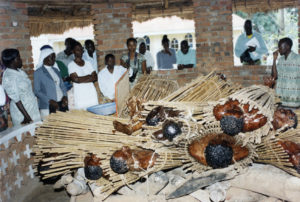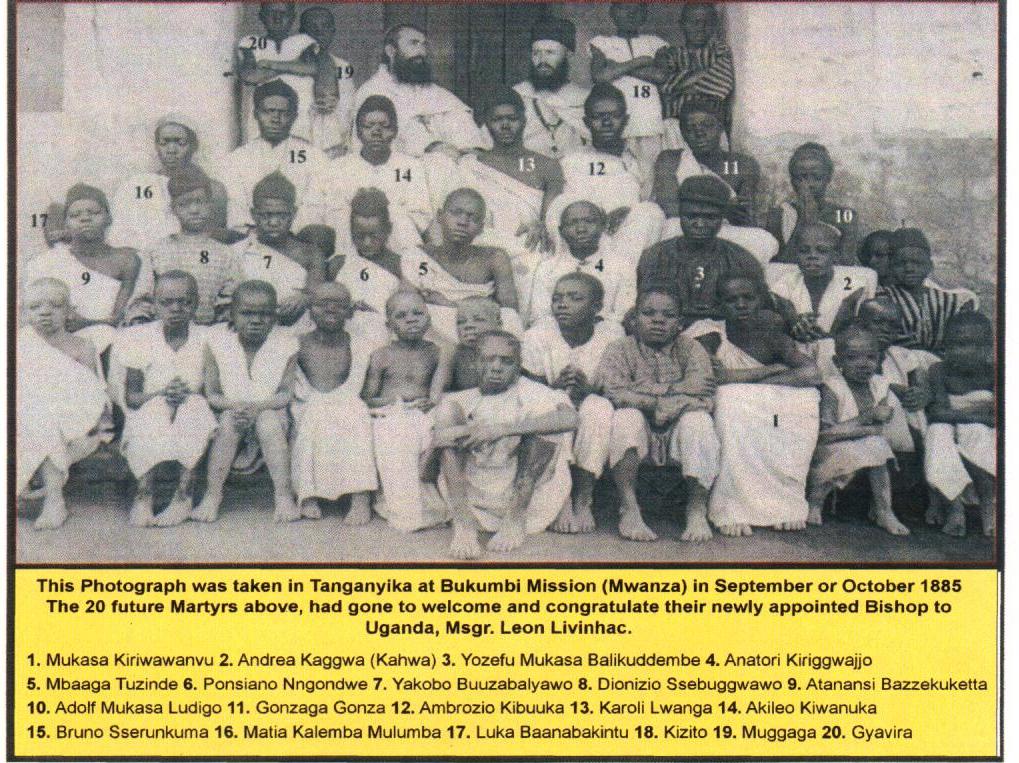THE MARTYRS OF UGANDA (1885-1887)
 In the period 1885-1887 in the kingdom of Buganda, in the central region of Uganda, King Kabaka Mwanga started to persecute the new Christian converts and many were put to death. Of these Catholic martyrs, Charles Lwanga and 21 companions were canonized in 1964 by Pope Paul VI. The Anglican Church recognizes 23 of their members killed at the same time, also as martyrs for the faith.
In the period 1885-1887 in the kingdom of Buganda, in the central region of Uganda, King Kabaka Mwanga started to persecute the new Christian converts and many were put to death. Of these Catholic martyrs, Charles Lwanga and 21 companions were canonized in 1964 by Pope Paul VI. The Anglican Church recognizes 23 of their members killed at the same time, also as martyrs for the faith.
The shrine to the Catholic Martyrs of Uganda at Namugongo has become a very popular place of pilgrimage for people, not only from Uganda, but also from many other African countries. Three Popes have also visited the shrine, Pope Paul VI in 1969, Pope John Paul II in 1993 and Pope Francis in 2015. This shows the importance of the Namugongo Shrine especially for the young Churches of Africa.
Courage of the Martyrs
These martyrs were all new converts to the faith and some were still catechumens, and only baptized before being killed. For three years they had to carry on by themselves, without the small community of Missionaries of Africa (White Fathers), who were forced to leave the area because of the persecution of the Christians. One of them, Fr Lourdel, was back in the area a short time before most of the martyrs were killed at Namugongo in June 1887. He was a witness to their terrible sufferings and encouraged them in every way he could. They were mostly young people in their teens and twenties, and faced death with great courage and even joy. The youngest one, Kizito, was only 14 years of age.
The first Catholic martyr was Joseph Mukasa, a senior advisor in the king’s court where the martyrs were employed as pages and helpers. Joseph opposed the king’s attempt to use the younger page boys as his sex partners. The king became furious and ordered that Joseph be burned alive. Joseph very courageously told his executioner that, “A Christian who gives his life to God has no reason to fear death…tell Mwanga that he has condemned me unjustly, but I forgive him with all my heart”. The executioner mercifully beheaded Joseph before throwing his body on the fire. Joseph Mukasa had been the leader of the small group of believers that was to grow rapidly after his death. These young Catholics then looked to Charles Lwanga to guide them.
After the death of Joseph Mukasa, some more Catholics were put to death, but the killing of the main group took place at Namugongo on the 3rd of June 1887. On the way to the place of execution, one of them turned to Fr. Lourdel and said, “Father, why be sad? What I suffer now is little compared with the eternal happiness you have taught us to look forward to.” They were brave and joyful to the end as they prayed, sang hymns and encouraged one another. Charles Lwanga was singled out to be the first to be thrown onto the huge fire. He went along willingly and the others bravely followed his example.
Witnesses to God’s Plan for Human Sexuality
The martyrs of Uganda gave their young lives as witnesses to God’s plan for human sexuality. This precious gift of God finds its proper expression in the lifelong faithful union of a man and a woman in marriage, who are open to bringing new life into the world. These young martyrs were not going to be lured, even by the powerful and cruel paedophile king, into the homosexual lifestyle which runs counter to the whole meaning and purpose of sexuality.
All the urges and drives of our bodies whether for food, drink or sex, have to be controlled and directed or else they will control us, and harm or destroy us. People have no problem in acknowledging this obvious truth as regards food and drink, in order to ensure health and fitness. When it comes to sexuality, there is a massive blind spot due largely to the incessant and insidious propaganda and brainwashing over many decades, promoting a totally free-for-all attitude to sex. For very many people this has resulted in feelings, emotions and desires, taking the place of facts, truth and common sense, with no boundaries, no guidelines, no right or wrong form of behaviour.
This totally irresponsible attitude towards the precious gift of sexuality, obviously opens the way towards all kinds of sexual perversion as pointed out by Sigmund Freud, the father of modern psychoanalysis and himself an atheist. He wrote, “The abandonment of the reproduction function is the common feature of all perversions. We actually describe a sexual activity as perverse if it has given up the aim of reproduction, and pursues the attainment of pleasure as an aim independent of it” (quoted by Christopher West:” Good News About Sex and Marriage” P.122).
The homosexual lifestyle is not in accordance with God’s plan stamped on human beings as male and female, but is a form of sexual perversion, going against nature. It has nothing to do with reproduction which is the bringing children into the world, but is focused solely on the sexual pleasure of adults. Two people of the same sex are simply not capable of performing the marital act and it is ludicrous to speak of homosexual “marriage”. The union of two people of the same sex may be regarded as a kind of emotional bond but it is definitely not a marriage.
This kind of union is being legalised as a “marriage” on the basis of equality, claiming that traditional marriage between a man and a woman is discriminatory and outdated. This is obviously untrue. This deconstruction of marriage is giving the false message that all civilisations, cultures and religions up to the present time, have got it wrong in restricting marriage to the union of a man and a woman, and that the modern secularist culture has finally got it right by promoting homosexual marriage!
The prevalence of homosexuality is often exaggerated in the media. In reality only about 1.5 percent of the population consider themselves to be exclusively homosexual. There is no evidence of a gay gene and so nobody is born as a homosexual. It should not surprise anyone that this kind of lifestyle might involve health risks, since nature tends to take its revenge when its laws are broken.
The homosexual lifestyle commonly leads to a shorter life span and, in relation to the rest of the population, a considerably increased risk of contracting various sexually transmitted diseases including HIV/AIDS – and there are up to 35 such diseases altogether. There is also a significantly increased danger of other side-effects such as, violence, substance abuse through drugs and alcohol, depression and suicide. Any society which outlaws smoking as a health risk should also reject same-sex “marriage” for the same reason.
Many adolescents go through a period of confusion about whether they are heterosexual or homosexual, but practically all of them grow out of this and eventually find that they are heterosexual. However, if during this period of uncertainty about their sexual identity, they get exposed to the gay lifestyle, there is a real risk that they will become homosexuals. The same is true of children who grow up in homosexual households.
The Teaching of the Church on Homosexuality
The teaching of the Bible condemning homosexual activities is very clear in the Old Testament (Lev 18;22; 20:13) and also in the New Testament (Rom 1;26-27; 1 Cor 6;9 1; Tim 1-10). St. Paul uses strong language in condemning homosexual activities, but he does so out of love because he wants people to know the truth, and to experience the joy and happiness of living according to God’s law of love.
Referring to those who had ignored the truth about human sexuality and got involved in homosexual behaviour, St. Paul writes that, “God gave them up to dishonourable passions. Their women exchanged natural relations for unnatural, and the men likewise gave up natural relations with women, and were consumed with passion for one another, men committing shameful acts with men, and receiving in their person the due penalty for their error. And since they did not see fit to acknowledge God, God gave them up to a base mind and to improper conduct” (Rom. 1:26-28).
The Church has been faithful to this teaching down through the centuries, and has stressed it especially at times when some were ignoring it. In the 11th century, St. Peter Damian (1007-1072), one of the great Saints and doctors of the church, in his “Book of Gomorrah” took a strong stand against homosexual practices among the clergy of his time, urging the Pope, St. Leo IX, to deal with this “lethal wound festering in the very body of the holy church”. And the church did take action.
Five hundred years later the church had to again deal with the serious challenge of the homosexual lifestyle among many of her members including the clergy. There was a strong and decisive response from Pope St. Pius V. He set down strict directives to stamp out the practice of homosexuality especially among the clergy. He referred to it as “that horrible crime” which “causes us most bitter sorrow and shocks our mind, impelling us to repress such crime with the greatest possible zeal” (Apostolic Constitution “Horrenduus illud scelus 1568). It is interesting to note that these two Popes, Pope Leo 1X and Pope Pius V, both became canonised saints.
The Catechism of the Catholic Church deals with homosexuality in a truthful, loving and compassionate manner. People wish to hear the truth when it comes to their physical or emotional health, but it is even more important when it comes to their spiritual wellbeing. The Catechism gives the truth by pointing out that homosexual acts are “contrary to the natural law. They close the sexual act to the gift of life. They do not proceed from a genuine affective and sexual complementarity. Under no circumstances can they be approved” (CCC 2357).
The truth, contained in the Bible and the traditional teaching of the Church, even if at times it is not welcome, is nonetheless compassionate, loving and merciful. Nobody can be more compassionate than God Himself! The Catechism admits that the homosexual inclination is for “most of them a trial”. It says that homosexuals “must be accepted with respect, compassion and sensitivity. Every form of unjust discrimination against them must be avoided”. There is nothing evil or sinful about same-sex attraction in itself but it can be a heavy cross to carry. The challenge is how to deal with it in order to ensure a happy and healthy life.
The Catechism reminds people with same-sex attraction that they are “called to chastity” and that through self-mastery, prayer and the sacraments, “they can and should gradually and resolutely approach Christian perfection” – in other words become saints (CCC 2357 – 2359). On their faith journey, many with same sex orientation have been helped by organisations such as “Courage International” and “NARTH” (National Association for Research and Treatment of Homosexuality), as well as by the teaching of the Catechism on the vocation to chastity (CCC 2337-2359).
Relevance of the Martyrs of Uganda
 The courageous witness of these young men to the truth about human sexuality is very relevant to the work of evangelisation. They have had a profound influence on the growth and development of the Church in Uganda and the neighbouring countries. At their canonization in 1964, Blessed Paul V1 spoke of their importance in transforming the local culture through the teaching of the Gospel. He said, “These martyrs of Africa have laid the foundation of a new age”. He went on to say that they have provided “sufficient lessons for the formation of a new people, for the foundation of a new spiritual tradition … a new civilization”.
The courageous witness of these young men to the truth about human sexuality is very relevant to the work of evangelisation. They have had a profound influence on the growth and development of the Church in Uganda and the neighbouring countries. At their canonization in 1964, Blessed Paul V1 spoke of their importance in transforming the local culture through the teaching of the Gospel. He said, “These martyrs of Africa have laid the foundation of a new age”. He went on to say that they have provided “sufficient lessons for the formation of a new people, for the foundation of a new spiritual tradition … a new civilization”.
The Martyrs of Uganda are also very relevant to the modern world, where the truth about human sexuality, has to a great extent given way to massive confusion and the widespread rejection of traditional moral values. The example of these young men challenges people to look critically at what is happening, and try to promote the human and Christian values around sexuality.
There is now not only the issue of the homosexual lifestyle but also that of transgederism. A boy who feels he is a girl is told he can become one through hormone treatment and surgery. It is likewise for a girl who feels she is a boy, she too can change her identity and become a boy. But in reality there is no way of changing one’s DNA – a person born as a man or a woman will live and die as such. The number of people in this category is very small, only about .014 of the population. Again they should be accepted with love and understanding. They are entitled to know the truth about their condition, and should get all the help they need to bring about healing and integration in their lives.
What St. John Paul 11 said about attacks on human life also applies to attacks on traditional moral values around sexuality, marriage and family. In his words, “We are facing an enormous and dramatic clash between good and evil, death and life, the ‘culture of death’ and the ‘culture of life’” (“The Gospel of Life” 28). Since human sexuality has as its fundamental purpose the bringing of new life into the world, it is part of the culture of life. For the Christian there is only one choice and that is to stand up for the truth, and promote the whole culture of life, not only with regard to abortion and euthanasia but also concerning human sexuality.
Here again, as with abortion, there are many who adopt the attitude that, “Personally I’m against homosexual “marriage” and the whole gender agenda, but if others want it they are entitled to have it”. In reality such an attitude is giving support to what is morally wrong, and undermines the institution of marriage which is so important for a healthy society. It goes against the Natural Law written in human hearts. The Catechism gives the comforting message that even if people try to suppress the Natural Law it will always emerge again. It teaches that “The Natural Law is immutable and permanent throughout the variations of history …. Even when it is rejected in its very principles, it cannot be destroyed or removed from the heart of man. It always rises again in the life of individuals and societies” (CCC 1958).
All people and especially those with same sex attraction can draw courage and inspiration from the example of the Uganda Martyrs, in rejecting any kind of involvement in homosexual behaviour. They are important role models for promoting the gospel of life and the virtue of chastity. People can turn to these saints and confidently ask for their powerful intercession to live chaste and happy lives, with the hope of one day joining them in the great company of saints and martyrs in heaven.